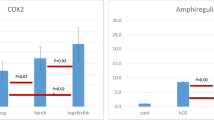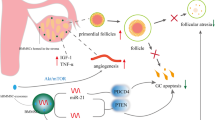Abstract
Nongonadal tissues express luteinizing hormone-chorionic gonadotropin receptors (LHCG-R) which are essential for their growth during fetal development. Adult mesenchymal stem/stromal cells (MSCs) have been shown to express functional LHCG-R outside pregnancy conditions, making them susceptible to hCG stimulation. In the present study we tested the effect of hCG treatment on bone marrow (BM) derived adherent stem cells in vitro, isolated from a parous women, mother of male sons, in order to evaluate its effect on maternal MSCs and in the same time on fetal microchimeric stem cells (FMSCs), to better understand the outcomes of this safe and affordable treatment on cell proliferation and expression of pluripotency genes. Our study highlights the beneficial effects of hCG exposure on gene regulation in bone marrow adherent stem cells through the upregulation of pluripotency genes and selection of more primitive mesenchymal stem cells with a better differentiation potential. Validation of these effects on MSCs and FMSCs long after parturition in vivo represents a close perspective as it could set the premises of a new mobilization strategy for the stem cell transplantation procedures in the clinical setting.















Similar content being viewed by others
References
Bifari, F., Lisi, V., Mimiola, E., Pasini, A., & Krampera, M. (2008). Immune modulation by mesenchymal stem cells. Transfusion Medicine and Hemotherapy, 35, 194–204. https://doi.org/10.1159/000128968.
Cismaru, C. A., Pop, L., & Berindan-Neagoe, I. (2018). Incognito: are microchimeric fetal stem cells that cross placental barrier real emissaries of peace? Stem Cell Reviews and Reports. https://doi.org/10.1007/s12015-018-9834-9.
O’Donoghue, K., Chan, J., de la Fuente, J., Kennea, N., Sandison, A., Anderson, J. R., Roberts, I. A., & Fisk, N. M. (2004). Microchimerism in female bone marrow and bone decades after fetal mesenchymal stem-cell trafficking in pregnancy. Lancet, 364(9429), 179–182.
Krampera, M., Marconi, S., Pasini, A., Galiè, M., Mosna, F., Tinelli, M., Lovato, L., Anghileri, E., Andreini, A., Pizzolo, G., Sbarbati, A., & Bonetti, B. (2007). Induction of neural-like differentiation in human mesenchymal stem cells derived from bone marrow, fat, spleen and thymus. Bone, 40, 382–390.
Sato, Y., Araki, H., Kato, J., Nakamura, K., Kawano, Y., Kobune, M., Sato, T., Miyanishi, K., Takayama, T., Takahashi, M., Takimoto, R., Iyama, S., Matsunaga, T., Ohtani, S., Matsuura, A., Hamada, H., & Niitsu, Y. (2005). Human mesenchymal stem cells xenografted directly to rat liver are differentiated into human hepatocytes without fusion. Blood, 106, 756–763.
Le Blanc, K., Tammik, L., Sundberg, B., et al. (2003). Mesenchymal stem cells inhibit and stimulate mixed lymphocyte cultures and mitogenic responses independently of the major histocompatibility complex. Scandinavian Journal of Immunology, 57, 11.
Fang, L., Lange, C., Engel, M., Zander, A. R., & Fehse, B. (2006). Sensitive balance of suppressing and activating effects of mesenchymal stem cells on T cell proliferation. Transplantation, 82, 1370–1373.
Wang, L., Zhu, C., Ma, D., et al. (2018). Efficacy and safety of mesenchymal stromal cells for the prophylaxis of chronic graft-versus-host disease after allogeneic hematopoietic stem cell transplantation: a meta-analysis of randomized controlled trials. Annals of Hematology, 97, 1941.
Kucia, M., Reca, R., Campbell, F. R., Zuba-Surma, E., Majka, M., Ratajczak, J., et al. (2006). A population of very small embryonic-like (VSEL) CXCR4(+)SSEA-1(+)Oct-4+ stem cells identified in adult bone marrow. Leukemia, 20, 857–869.
Ratajczak, M. Z., Machalinski, B., Wojakowski, W., Ratajczak, J., & Kucia, M. (2007). A hypothesis for an embryonic origin of pluripotent Oct-4þ stem cells in adult bone marrow and other tissues. Leukemia, 21, 860–867.
Abdallah, M. A., Lei, Z. M., Li, X., Greenwold, N., Nakajima, S. T., Jauniaux, E., & Rao, C. V. (2004). Human fetal nongonadal tissues contain human chorionic gonadotropin/ luteinizing hormone receptors. The Journal of Clinical Endocrinology and Metabolism, 89(2), 952–956.
Ascoli, M., Fanelli, F., & Segaloff, D. L. (2002). The lutropin/choriogonadotropin receptor, a 2002 perspective. Endocrine Reviews, 23(2), 141–174.
Tourkova, I. L., Witt, M. R., La Li, Q. L., Liu, L., Luo, J., Robinson, L. J., & Blair, H. C. (2015). Follicle stimulating hormone receptor in mesenchymal stem cells integrates effects of glycoprotein reproductive hormones. Annals of the New York Academy of Sciences, 1335(1), 100–109.
Meng, X. L., Rennert, O. M., & Chan, W. Y. (2007). Human chorionic gonadotropin induces neuronal differentiation of PC12 cells through activation of stably expressed lutropin/choriogonadotropin receptor. Endocrinology, 148(12), 5865–5873.
Cakouros, D., & Gronthos, S. (2019). Epigenetic regulation of bone marrow stem cell aging: revealing epigenetic signatures associated with hematopoietic and mesenchymal stem cell aging. Aging and Disease, 10(1), 174–189.
Cismaru, C. A., Soritau, O., Jurj, A., Raduly, L., Pop, B., Bocean, C., Albzour, B., Baldasici, O., Moldovan, C., & Neagoe, I. B. (2019). Isolation and characterization of a fetal-maternal microchimeric stem cell population in maternal hair follicles long after parturition. Stem Cell Reviews and Reports, 15(4), 519–529. https://doi.org/10.1007/s12015-019-09885-4.
Ben-Shushan, E., Thompson, J. R., Gudas, L. J., & Bergman, Y. (1998). Rex-1, a gene encoding a transcription factor expressed in the early embryo, is regulated via Oct-3/4 and Oct-6 binding to an octamer site and a novel protein, Rox-1, binding to an adjacent site. Molecular and Cellular Biology, 18(4), 1866–1878.
Zahn, C., Hommel, A., Lu, L., Hong, W., Walther, D. J., Florian, S., Joost, H. G., & Schürmann, A. (2006). Knockout of Arfrp1 leads to disruption of ARF-like1 (ARL1) targeting to the trans-Golgi in mouse embryos and HeLa cells. Molecular Membrane Biology, 23(6), 475–485.
Graf, D., Nethisinghe, S., Palmer, D. B., Fisher, A. G., & Merkenschlager, M. (2002). The developmentally regulated expression of Twisted gastrulation reveals a role for bone morphogenetic proteins in the control of T cell development. The Journal of Experimental Medicine, 196(2), 163–171.
Vacca, M., Murzilli, S., Salvatore, L., Di Tullio, G., D’Orazio, A., Lo Sasso, G., Graziano, G., Pinzani, M., Chieppa, M., Mariani-Costantini, R., Palasciano, G., & Moschetta, A. (2013). Neuron-derived orphan receptor 1 promotes proliferation of quiescent hepatocytes. Gastroenterology, 144(7), 1518–1529.e3.
Kalantry, S., Manning, S., Haub, O., Tomihara-Newberger, C., Lee, H. G., Fangman, J., Disteche, C. M., Manova, K., & Lacy, E. (2001). The amnionless gene, essential for mouse gastrulation, encodes a visceral-endoderm-specific protein with an extracellular cysteine-rich domain. Nature Genetics, 27(4), 412–416.
Available online at https://www.ncbi.nlm.nih.gov/gene/90665
Mincheva-Nilsson, L., & Baranov, V. (2012). Placenta- derived exosomes and their role in the immune protection of the fetus. Recent Advances in Research on the Human Placenta. Chapter. March pg. 243–260.
Rakesh Popli, Bita Sahaf, Hideki Nakasone, Joyce Yeuk Yu Lee, and David B. Miklos. Clinical impact of H-Y alloimmunity. Immunologic Research 2014; 58(0): 249–258.
Bhat, M. A., Sharma, J. B., Roy, K. K., Sengupta, J., & Ghosh, D. (2019). Genomic evidence of Y chromosome microchimerism in the endometrium during endometriosis and in cases of infertility. Reproductive Biology and Endocrinology, 17(1), 22.
Taichman, R. S., Wang, Z., Shiozawa, Y., Jung, Y., Song, J., Balduino, A., Wang, J., Patel, L. R., Havens, A. M., Kucia, M., Ratajczak, M. Z., & Krebsbach, P. H. (2010). Prospective identification and skeletal localization of cells capable of multilineage differentiation in vivo. Stem Cells and Development, 19(10), 1557–1570. https://doi.org/10.1089/scd.2009.0445.
Crisan, M., et al. (2008). A perivascular origin form MSC in multiple human organs. Cell Stem Cell, 3(3), 301–313. https://doi.org/10.1016/j.stem.2008.07.003.
Caplan, A. I. (2008). All MSCs Are Pericytes? Cell Stem Cell, 3(3), 229–230. https://doi.org/10.1016/j.stem.2008.08.008.
Bhartiya, D. (2018). The need to revisit the definition of mesenchymal and adult stem cells based on their functional attributes. Stem Cell Research & Therapy, 9, 78. https://doi.org/10.1186/s13287-018-0833-1.
Bhartiya, D. (2013). Are mesenchymal cells indeed pluripotent stem cells or just stromal cells? OCT-4 and VSELs biology has led to better understanding. Stem Cells International, 2013, 547501. https://doi.org/10.1155/2013/547501.
Shaikh, A. Pluripotent stem cells in bone marrow and cord blood. Blood Cells, chapter 4, pp. 980–953, http://www.intechopen.com/download/pdf/39122.
Michaeli, T. F., Bergman, Y., & Gielchinsky, Y. (2015). Rejuvenating effect of pregnancy on the mother. Fertility and Sterility®, 103(5), 0015–0282.
Author information
Authors and Affiliations
Corresponding author
Ethics declarations
Conflict of Interests
All authors have reviewed and approved this version of the manuscript, and prudent care was taken to confirm the integrity of the work. No fragment of this article has been published or submitted elsewhere. There is no financial conflict of interest in the submission of this article.
Ethical Approval
The study involving human participants was approved by the ethics committee of the University of Medicine and Pharmacy “Iuliu Hatieganu” Cluj-Napoca, reg. no. 100/08.03.2017 and informed consent was obtained prior to tissue sample analysis.
Additional information
Publisher’s Note
Springer Nature remains neutral with regard to jurisdictional claims in published maps and institutional affiliations.
Rights and permissions
About this article
Cite this article
Cismaru, A.C., Soritau, O., Jurj, A.M. et al. Human Chorionic Gonadotropin Improves the Proliferation and Regenerative Potential of Bone Marrow Adherent Stem Cells and the Immune Tolerance of Fetal Microchimeric Stem Cells In Vitro. Stem Cell Rev and Rep 16, 524–540 (2020). https://doi.org/10.1007/s12015-020-09957-w
Published:
Issue Date:
DOI: https://doi.org/10.1007/s12015-020-09957-w




